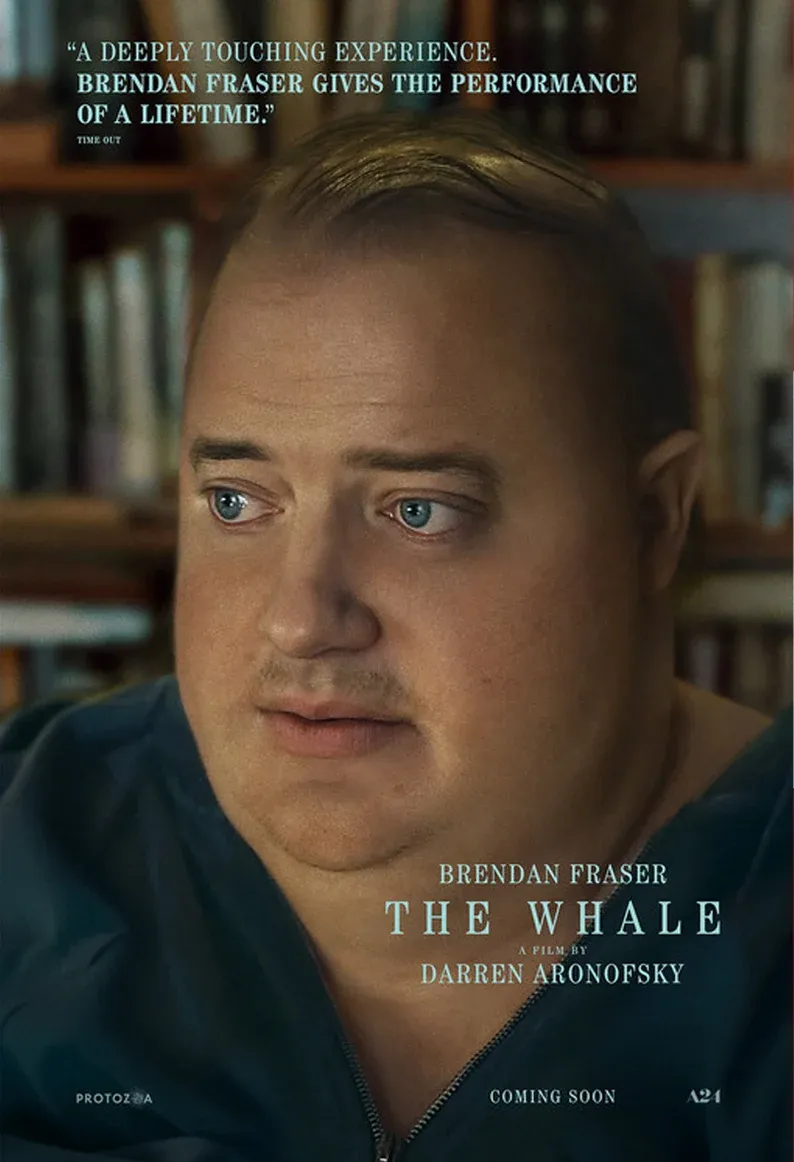FILM REVIEW: The feast of grief, claustrophobia, hope and abjection in The Whale (2023)

I have never written a film review but I was bowled over by The Whale (2023), so I wanted to try my hand at it.
And after all, this website is a place for me to explore creativity and writing – so I thought why not?
I prefer my reviews spoiler free so that is how I’ll write it, with the bare minimum allusions to the plot because I thoroughly recommend you should watch it yourself if you haven’t already.
The key components are an overview, explorations of the key roles played by setting, hope and abjection followed by a conclusion.

Overview
The Whale is at its core a character study that explores the devastating impact grief inflicts on us but also those around us.
The story coalesces around Charlie, played exquisitely by Brendan Fraser, who is a morbidly obese man trying to reconnect with his family.
The opening scene is intense, uncomfortable, awkward and makes us feel like we are intruding into a deeply intimate episode of Charlie’s life.
This smorgasbord of emotions rarely lets up as the movie unfolds.
We witness Charlie’s daily life where he works as an online English tutor for a community college, struggles to move around his apartment and receives visits from a close friend Liz – played by Hong Chau – who is a nurse and effectively Charlie’s carer.

We meet other characters like Charlie’s estranged daughter Ellie (Sadie Sink), his ex-wife Mary (Samantha Morton), a passing missionary called Thomas (Ty Simpkins), and – mostly from behind a closed door – the pizza delivery guy, Dan (Sathya Sridharan).
In terms of a traditional ‘plot’ very little happens in The Whale.
We glimpse a small slice of Charlie’s existence, gradually learning about his deep grief and how he came to live this way.
But it is far from a simplistic experience.
These are some of the main elements of The Whale that make it a tremendous cinematic experience:
Setting as device
With a small cast and claustrophobic setting, the intensity of The Whale never lets up.
Charlie’s apartment is beige and dimly lit, with blinds covering all his windows except one (see The Bird below) for almost the entire film.
The protagonist is shutting out the outside world and it transforms his environment into a dingy den.
The camera angles and close-ups reflect the cramped space, yanking the viewer into the apartment by the throat and forcing them to confront Charlie’s living conditions.
Charlie’s sheer size alongside the volume of clutter and debris littering the apartment shrink the space further, heightening the discomfort for viewers.
And there is little relief from the few supporting characters populating the setting as they each arrive at Charlie’s apartment with their own emotional baggage, increasing the pain manifesting in one apartment.
But there is a small ray of hope in the dark.
The Bird
Charlie leaves one window open, unfettered by flimsy blinds.
It looks out to a brick wall – possibly explaining Charlie’s openness to leaving it uncovered because no one can look in – but does provide some light.
Outside this window, Charlie leaves a plate with crumbs on it and a blackbird feeds from this makeshift table.
The sound of the bird singing and chirping is pure and melodical, contrasting with the conditions Charlie lives in poignantly.
We don’t have to make a huge leap to interpret this bird and the light struggling to pierce the squalid conditions inside as hope, but it is still moving nonetheless.
Abject revulsion
Wendy Ide pointed out in her review of The Whale for the Guardian that: “if it were possible for a camera lens to sweat, then cinematographer Matthew Libatique’s would probably do so throughout.”
Ide connects this slipperiness to what she perceives as director Darren Aronofsky’s underhanded manipulation of the viewer.
But there is more to the role of bodily functions than this because they make the viewer feel abject revulsion.
For most of the film, Charlie is clammy and perspiring.
We see him gorge on food until he makes himself vomit into the bin.
In another tense scene, Charlie chokes on his food while eating too quickly and Liz has to intervene by slamming on his back – the blockage erupting from the protagonist.
Without diving too deeply into Julia Kristeva’s Powers of Horror, she refers to the abject as the profound and disturbing sensation caused by encountering the corpse and other bodily products like vomit, faeces, wounds and even things like the skin on dairy products. Kristeva argues that these things traumatically remind us of our own materiality, highlighting the breakdown in meaning caused by the loss of the distinction between subject and object or between self and other.
In The Whale, viewers confront the abject for most of the film which unrelentingly thrusts Charlie’s poor health, his dying body and its by products in our faces.
Some might find this off-putting and detracting from their experience.
But cinema is at its best when it evokes strong emotional and at times even physical reactions from its viewers.
And The Whale undeniably achieves this with the deployment of abject revulsion.
Conclusion
The Whale hit me like a tidal wave and I highly recommend seeing it.
If you can catch it in the cinema – I watched it with my partner at the wonderful Cinema City in Norwich – it is worth the effort because I’m not sure the towering performance and presence of Brendan Fraser’s Charlie would be as powerful without the silver screen as a delivery mechanism.
The film captures a complex interplay of emotions and experiences – love and hate, grief and hope, healing and decay, selfishness and generosity.
The characters coalesce around Charlie and their stories are interwoven with his own deeply sad story.
The cinematography and soundtrack combined with the crucial elements of setting, hope and abjection are profoundly powerful.
And it is the sheer emotional clout which almost brings about a physical reaction in the viewers which is the greatest achievement of The Whale.
Have you seen The Whale and if so what did you think of the movie?
Start commenting and join the conversation by scrolling down the Member discussion section below.
A small request
Thanks for stopping by. If you enjoyed the post and think others might do too, I would greatly appreciate it if you helped me reach them.
One way you can help is by sharing this article on social media or forwarding it to anyone you think might get value from these posts and the newsletter.
Another is by heading over to Twitter and connecting with me – it’s the social media platform I use most so you're most likely to catch me there.
If you are new here - click the button below to join the community receiving my newsletter.





Member discussion